How to Fertilize Aquarium Plants Naturally: Guaranteed Methods for Optimal Growth
- April 16, 2024
- 1 comment
Learn how to fertilize aquarium plants naturally with our guaranteed methods for optimal growth. Achieve lush greenery and vibrant health with ease. Enhancing the health and vibrancy of your aquarium plants through natural means not only promotes a thriving underwater environment but also maintains the delicate ecological balance. This guide explores a variety of proven, eco-friendly methods that guarantee optimal growth.
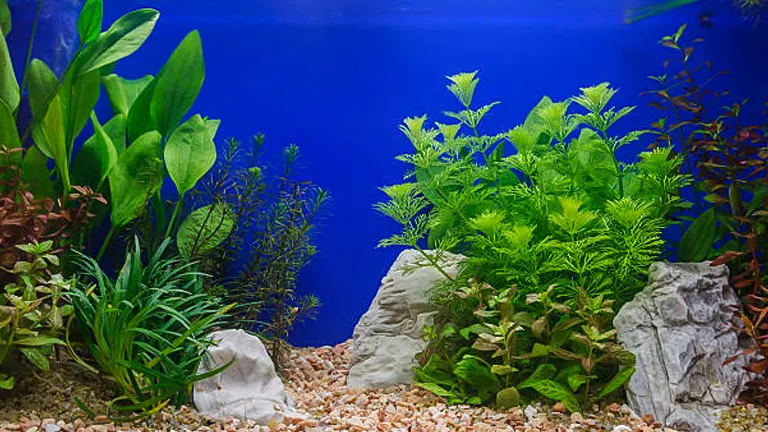
Discover simple homemade solutions and understand the science behind natural fertilizers to unlock the full potential of your aquatic greenery. Embrace these sustainable practices that lead to lush, robust growth and transform your aquarium into a vibrant ecosystem.
Table of Contents
- The Role of Nutrients in Aquatic Plant Health
- Natural Fertilizer Sources for Aquarium Plants
- Step-by-Step Guide to Fertilizing Aquarium Plants Naturally
- Cost Analysis of Natural Fertilization
- Environmental Impact and Sustainability
- Advanced Fertilization Techniques
- Troubleshooting Common Issues
- Conclusion
- FAQs
The Role of Nutrients in Aquatic Plant Health

Aquarium plants need a balanced mix of nutrients to perform essential biological functions. Macronutrients such as nitrogen, phosphorus, and potassium support growth and vitality, while micronutrients like iron and manganese are crucial for the development of enzymes and chlorophyll.
- Nitrogen is critical for protein synthesis, forming the building blocks of the plant tissues and essential for the growth of leaves and stems. It is primarily sourced from fish excrement and decomposing feed, which are converted by aquarium bacteria into forms that plants can absorb. Insufficient nitrogen typically manifests as chlorosis, where leaves turn pale or yellow, starting with older leaves as nitrogen is relocated to support new growth.
- Phosphorus is vital for energy transfer within plants, playing a significant role in photosynthesis and cellular energy processes. It helps in root development and blooming in flowering plants. Deficiency in phosphorus can stunt growth or cause leaves to darken and dull.
- Potassium is necessary for various plant functions, including protein synthesis, osmoregulation, and the activation of enzymes. It helps strengthen cellular processes and enhances the overall health and drought resistance of plants. Symptoms of potassium deficiency include pinholes in leaves which may progress to edge necrosis.
Deficiencies in any of these nutrients can lead to stunted growth, discolored leaves, and a general decline in plant health. For instance, nitrogen deficiency often manifests as pale or yellow leaves, phosphorus shortage might stunt growth or lead to dark, dull leaves, and potassium deficiency can cause leaf edges to brown and curl.
The Impact of Micronutrients
While required in smaller amounts, micronutrients are essential for the intricate processes of plant metabolism and health.
- Iron is paramount for chlorophyll formation and is hence crucial for photosynthesis. It is the most commonly deficient micronutrient in planted aquariums, especially in setups with high pH levels where iron becomes insoluble and unavailable to plants. Symptoms of iron deficiency include chlorosis in new leaves, eventually leading to poor plant health if uncorrected.
- Manganese assists in the photosynthesis process, especially in the production of oxygen from water molecules. Manganese deficiency often results in interveinal chlorosis and necrotic spots on older leaves, which can severely affect plant growth.
- Zinc and Copper play critical roles in several enzyme systems and are necessary for the overall metabolic health of plants. Zinc is involved in auxin synthesis, a growth hormone, while copper is integral to photosynthesis. Deficiencies in these nutrients can lead to stunted growth, distorted leaf formation, and weakened disease resistance.
Spotting signs of micronutrient deficiencies early can prevent severe health issues. Chlorosis, or the yellowing of leaves usually starting at the tips, can indicate an iron deficiency, often rectified by adding natural sources of iron before the condition worsens.
Nutrient Summary Table for Aquatic Plants
Understanding the precise roles, common sources, symptoms of deficiency, and optimal concentration levels of essential nutrients can significantly enhance your approach to maintaining aquatic plant health. This table provides a structured summary:
| Nutrient | Primary Role | Common Sources | Deficiency Symptoms | Optimal Concentration |
|---|---|---|---|---|
| Nitrogen (N) | Essential for protein synthesis and chlorophyll formation. | Fish waste, decomposing organic matter. | Pale or yellow leaves, starting with older leaves. | 10-20 mg/L |
| Phosphorus (P) | Critical for energy transfer and root development. | Fish waste, food residues, supplements. | Stunted growth, dark, dull leaves. | 0.5-2.0 mg/L |
| Potassium (K) | Important for osmoregulation and enzyme activation. | Potassium fertilizers, some tap waters. | Pinholes in leaves progressing to edge necrosis. | 10-25 mg/L |
| Iron (Fe) | Integral for chlorophyll production and photosynthesis. | Chelated iron fertilizers. | Chlorosis in new leaves, stunted growth. | 0.1-0.5 mg/L |
| Manganese (Mn) | Aids in photosynthesis and the production of oxygen. | Micro-nutrient fertilizers, tap water. | Interveinal chlorosis, necrotic spots on leaves. | 0.01-0.5 mg/L |
| Zinc (Zn) | Vital for several enzyme systems and hormone synthesis. | Trace element solutions, comprehensive supplements. | Reduced leaf size, distorted growth. | 0.01-0.05 mg/L |
| Copper (Cu) | Key in many metabolic processes including photosynthesis. | Trace element solutions, copper supplements. | Leaf tip necrosis. | 0.01-0.02 mg/L |
This table encapsulates the critical nutrient parameters for maintaining healthy aquatic plants, providing a handy reference for both setting up new aquariums and troubleshooting existing setups. Each nutrient is listed with its biological importance, primary sources in an aquatic environment, typical signs of deficiency that can impact plant health, and the recommended concentrations to aim for in your tank.
Implementing Nutrient Management Strategies
- Regular Monitoring: To prevent nutrient imbalances and ensure the health of your aquatic plants, regular testing of water parameters is essential. This helps in making informed decisions about fertilization and adjustments needed to maintain optimal nutrient levels.
- Balanced Fertilization: Using comprehensive aquatic plant fertilizers can simplify the process of nutrient management. These products are formulated to provide all necessary macro and micronutrients in appropriate ratios, which is crucial for the complex needs of submerged plants.
- Observational Adjustments: The appearance of your plants can provide vital clues to their health. Regular observation for signs of nutrient deficiency or excess is crucial. Adjust fertilization practices based on observed symptoms and test results to tailor your approach to the specific needs of your aquarium plants.
- Consultation and Research: Continued learning and consultation with aquatic gardening experts can also enhance your understanding and approach. Many community forums and guides offer deep dives into more specific cases and solutions tailored to different types of aquatic environments.
Natural Fertilizer Sources for Aquarium Plants
Leveraging Fish Waste as a Nutrient Powerhouse
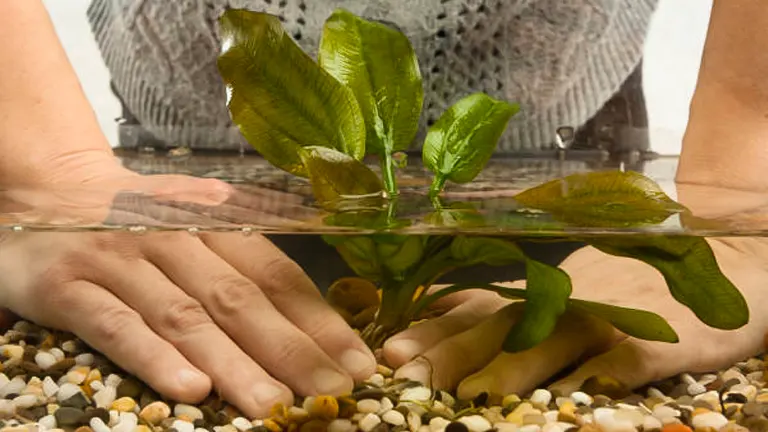
Fish waste is an invaluable source of nitrogen, which is crucial for plant growth. In an aquarium, nitrogen from fish waste undergoes a transformation by beneficial bacteria during the nitrogen cycle, converting it into forms that plants can readily absorb, such as nitrate.
- Optimizing Fish Waste Utilization:
- Balanced Fish Population: It’s essential to maintain an appropriate fish-to-water volume ratio to avoid overstocking. Overstocking leads to excessive waste which can deteriorate water quality and cause harmful fluctuations in nutrient levels.
- Regular Maintenance: Frequent cleaning of gravel and filters is necessary to prevent the accumulation of waste and ensure its conversion into beneficial nutrients. This includes vacuuming the substrate to remove detritus and rinsing filter media in discarded tank water.
DIY Organic Fertilizers
Creating your own fertilizers not only reduces costs but also increases environmental sustainability. Here are detailed methods to create effective home-based fertilizers:
- Eggshell and Coffee Ground Fertilizer:
- Ingredients: Rich in calcium and nitrogen, eggshells provide essential minerals, while coffee grounds offer nitrogen and a small amount of phosphorous and potassium.
- Preparation and Use: Dry and crush the eggshells; mix with used coffee grounds. This mixture can be buried under the substrate or steeped in water to make “compost tea,” which can then be added to the tank during water changes.
- Banana Peel Fertilizer:
- Potassium Source: Banana peels are a fantastic source of potassium, which is vital for the proper functioning of cellular processes in plants.
- Usage: Dry and cut the banana peels into small pieces, then either place them directly into the substrate or prepare a compost mixture by fermenting the peels in water, creating a nutrient-rich solution ideal for periodic supplementation.
Creating a Balanced Ecosystem
A balanced aquarium ecosystem efficiently cycles and distributes nutrients, reducing the need for frequent fertilization.
- Plant Diversity: Incorporating a variety of plants can enhance aesthetic appeal and improve the nutrient cycle. Different plants require and deplete nutrients at varying rates, which can help maintain balance within the ecosystem.
- Substrate Selection: The choice of substrate is pivotal in a planted aquarium.
- Nutrient Storage: Substrates rich in clay and organic material are excellent for nutrient retention. These substrates can store and slowly release nutrients back into the water column, where plant roots can absorb them.
Optimal Conditions and Benefits of Natural Fertilizers
| Fertilizer Type | Key Nutrients | Preparation | Benefits |
|---|---|---|---|
| Eggshell/Coffee Ground | Calcium, Nitrogen | Mix crushed eggshells with coffee grounds | Enhances root and leaf development, boosts overall growth |
| Banana Peels | Potassium | Dry and cut into pieces or ferment in water | Supports cellular functions and enzyme activation |
| Fish Waste | Nitrogen | Regular cleaning and balanced fish population | Sustains the nitrogen cycle, reduces need for supplements |
Step-by-Step Guide to Fertilizing Aquarium Plants Naturally
Step 1: Preparing Your Aquarium
Setting Up the Substrate: The right substrate not only supports the plants physically but also acts as a crucial nutrient reservoir.
- Choose the Right Type: Opt for substrates specifically designed for planted tanks, such as aqua-soil or clay gravel, which are rich in nutrients and have excellent water retention properties.
- Implement a Layered System: Place a nutrient-rich layer at the bottom, topped with a finer, inert layer to prevent nutrients from leaching too quickly.
Conditioning the Water: Water quality impacts plant health significantly; thus, proper preparation is essential.
- Dechlorinate the Water: Use a water conditioner to remove chlorine and chloramines, as these can harm beneficial bacteria essential for a balanced ecosystem.
- Adjust pH and Temperature: Ensure the water’s pH and temperature are appropriate for both plants and aquatic life to prevent stress and promote health.
Cycling the Tank: A well-cycled tank is foundational for establishing beneficial bacterial colonies that aid in nutrient cycling.
- Nitrogen Cycle: Allow 2-6 weeks for the tank to fully cycle, converting ammonia to nitrites and then nitrates, which plants can utilize as nutrients.
Step 2: Choosing and Introducing Plants
Select Appropriate Plants: Not all aquatic plants have the same nutrient needs; choose varieties that will thrive in the conditions you can provide.
- High Nutrient Demand: Plants like water wisteria and amazon swords require more nutrients and should be placed where nutrient flow is highest.
- Low Nutrient Demand: Anubias and ferns are less demanding and can thrive in lower-nutrient areas.
Planting Technique: Proper planting is crucial for root establishment and access to nutrients.
- Rooted Plants: Bury the roots gently in the substrate, ensuring not to cover the crown of the plant.
- Rhizome Plants: Attach these to rocks or wood, as burying their rhizomes can cause rot.
Step 3: Applying Natural Fertilizers
Utilize Fish Waste: Fish waste decomposes to release ammonia, which beneficial bacteria convert to nitrates, a plant-available form of nitrogen.
- Balanced Feeding: Feed fish appropriately to avoid excess waste. Overfeeding can lead to nutrient imbalances and algae issues.
- Regular Maintenance: Perform regular water changes and vacuum the substrate to manage waste and distribute nutrients evenly.
Create DIY Organic Fertilizers: Homemade fertilizers can be tailored to the needs of your plants and are environmentally friendly.
- Compost Tea: Brew tea from compost or a mixture of organic kitchen waste. This liquid can be used to add nutrients during water changes.
- Direct Substrate Addition: Bury biodegradable kitchen waste (e.g., banana peels, eggshells) under the substrate to slowly release nutrients.
Step 4: Optimizing Light and CO2
Lighting Requirements: Proper lighting is essential for photosynthesis, the process by which plants convert light energy into chemical energy.
- Intensity and Duration: Provide 8-10 hours of light per day. Use full-spectrum lights to simulate natural light conditions.
- Placement: Ensure that light evenly covers the plants, especially those that are densely planted and require more light.
CO2 Supplementation: Carbon dioxide is another critical component of photosynthesis.
- DIY CO2 Systems: Set up a simple yeast fermentation system to generate CO2 or use a citric acid/baking soda setup for a more controlled release.
- Liquid Carbon: As a simpler alternative, use liquid carbon products that provide bioavailable carbon for plants.
Step 5: Monitoring and Maintenance
Regular Testing: Monitoring water parameters is crucial for maintaining an environment conducive to plant growth.
- Test Nutrient Levels: Regularly check levels of nitrates, phosphates, potassium, and trace elements to ensure they are within optimal ranges for plant health.
- Adjustments: Based on testing results, adjust feeding, fertilizer dosing, and light to maintain balance.
Pruning and Cleaning: Healthy plants and a clean tank are essential for a thriving planted aquarium.
- Trim Dead or Overgrown Foliage: This helps prevent decay in the tank which can deplete oxygen and release harmful substances.
- Algae Control: Remove algae by hand or use natural algae eaters like certain fish or snails.
Cost Analysis of Natural Fertilization
Understanding the Financial Benefits
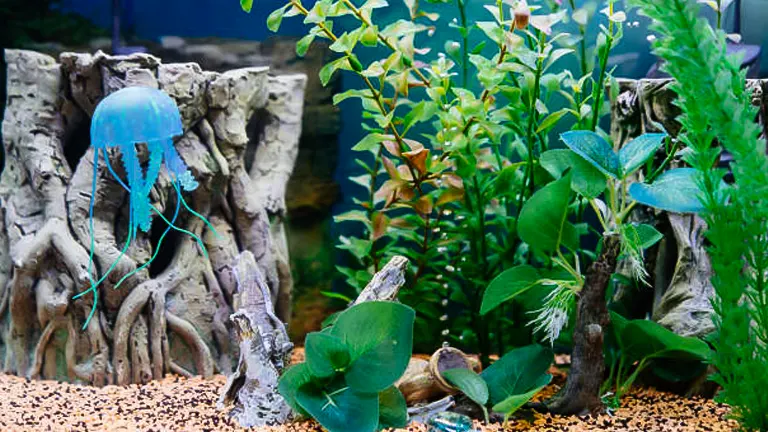
Natural fertilization methods offer significant long-term savings and environmental benefits compared to chemical fertilizers. This section breaks down the initial investment, ongoing costs, and potential savings to help you efficiently manage your aquarium with a focus on sustainability and cost-effectiveness.
Initial Investment
1. Substrate and Plant Setup
A thriving planted aquarium starts with the right foundation—from substrate to the selection of plants:
- Substrate Costs:
- Types: Nutrient-rich substrates like aqua-soil or specialized planted tank substrates.
- Costs: While these substrates are pricier upfront, costing approximately $30-$100 depending on tank size, they are essential for long-term plant health due to their nutrient content and water regulation properties.
- Plants:
- Cost Variation: Aquatic plants’ initial costs range from $5 for basic varieties to over $30 for rarer species.
- Investment Justification: Investing in higher-quality plants can mean better adaptability, growth, and fewer needs for replacements, which curtails long-term costs.
- Equipment:
- Lighting Systems: LED and full-spectrum fluorescent bulbs are ideal, though initial costs are high ($50-$200), they offer greater energy efficiency and plant growth efficacy.
- Filtration System: Crucial for maintaining clean water and nutrient circulation; initial costs ($100-$300) are offset by long-term reliability and ecosystem balance.
Recurring Expenses
2. DIY Natural Fertilizers
Using homemade fertilizers significantly reduces the need for commercial products:
- Compost Materials:
- Sources: Kitchen scraps, garden waste (leaves, grass clippings), and coffee grounds.
- Costs: Virtually free; requires collection and minimal processing using common household tools.
- Preparation Tools:
- Tools Needed: Blender for compost teas, containers for storage.
- Costs: Low; many households already possess these items. Specialty items like compost bins or DIY CO2 kits might cost $20-$50.
- Maintenance Costs:
- Water Testing Kits: Essential for maintaining nutrient balance, with kits costing $10-$50 and lasting several months depending on usage.
- Electricity Costs: While filtration and lighting systems do consume power, opting for energy-efficient models (LED lights, modern filters) can keep daily costs under control, typically $1-$3 per day depending on local electricity rates.
Cost-Benefit Analysis Table
| Cost Category | Details | Initial Cost | Recurring Cost |
|---|---|---|---|
| Substrate | Aqua-soil, clay gravel | $30-$100 | Not applicable |
| Plants | Variety based on tank ecosystem | $5-$30+ per plant | Not applicable |
| Lighting System | LED, full-spectrum bulbs | $50-$200 | $5-$10/month |
| Filtration System | Canister, HOB, sponge filters | $100-$300 | $2-$5/month |
| DIY Fertilizers | Compost tea, banana peels, eggshells | $0 (from scraps) | $0 (from scraps) |
| Preparation Tools | Blender, containers | $0-$50 | Not applicable |
| Maintenance (Water Testing, Electricity) | Kits, energy costs | $10-$50 (kits) | $30-$90/month |
Remark: The costs provided are estimates and may vary based on geographical location, market conditions, and specific aquarium needs. It is recommended to verify local prices and availability to ensure optimal purchasing decisions. Note that economic fluctuations and seasonal factors might also influence the prices, particularly of substrates and plants.
Environmental Impact and Sustainability
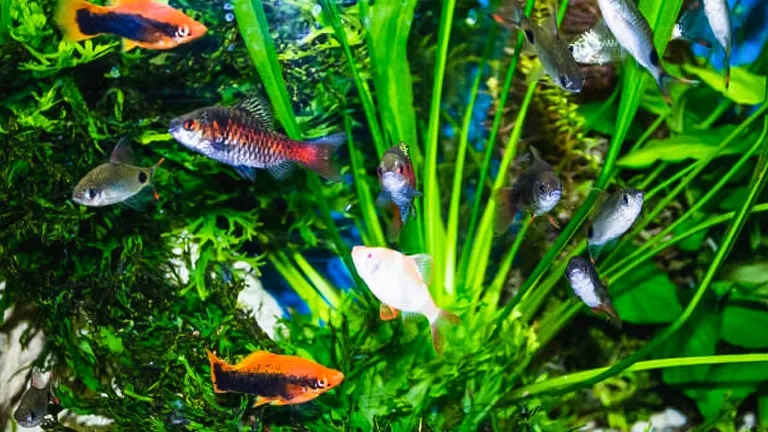
Adopting natural fertilization methods goes beyond just saving costs; it significantly reduces the environmental footprint of maintaining an aquarium. Here’s how natural fertilizing techniques stack up in terms of sustainability and eco-friendliness:
Reducing Chemical Use
Less Dependence on Chemical Fertilizers: Natural methods decrease the need for synthetic fertilizers that can leach harmful chemicals into waterways.
- Healthier Ecosystem: By using compost teas and DIY fertilizers, you promote a more natural growth environment that is safer for both aquatic and human life.
- Reduced Pollution: Chemical runoffs are a major contributor to water pollution. Natural fertilization helps minimize this risk, protecting local water sources.
Promoting Biodiversity
Supports More Varied Aquatic Life: A naturally fertilized tank provides a balanced ecosystem that supports a wider variety of plants and fish.
- Natural Food Sources: Organic waste fertilizers can also support microorganisms beneficial for fish diets, promoting a balanced food chain within the tank.
- Healthier Plant Growth: Natural fertilizers help cultivate a more diverse range of aquatic plants, which in turn supports varied marine life.
Sustainability Practices
Long-Term Environmental Benefits: Using natural resources wisely ensures sustainability and conserves the environment.
- Resource Conservation: Minimizes the exploitation of non-renewable resources such as phosphate and potassium mined for synthetic fertilizers.
- Waste Reduction: Utilizing kitchen and garden waste not only reduces the amount of organic waste heading to landfills but also turns it into a resource for growing plants.
Advanced Fertilization Techniques
Maximizing Plant Growth with CO2 and Light
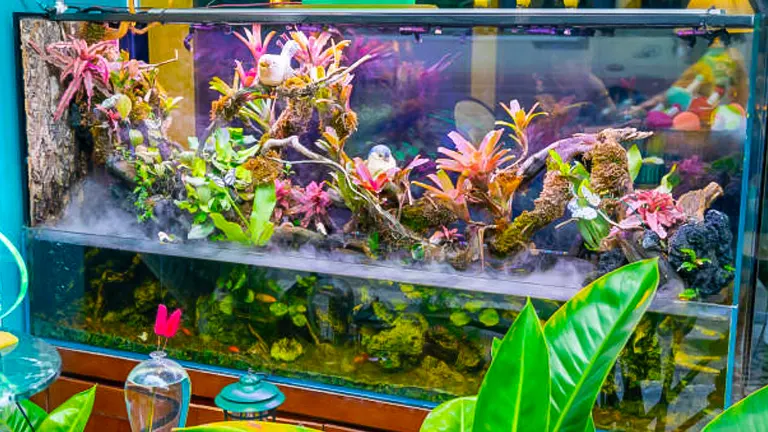
Effective carbon dioxide (CO2) supplementation and lighting are key to promoting robust plant growth in an aquarium. These elements are crucial for photosynthesis, the process by which plants convert light energy into chemical energy, which fuels their growth and maintenance.
Optimizing CO2 Levels
CO2 is a vital component of a thriving planted aquarium. Here’s how you can optimize CO2 levels naturally:
- Aquarium Bioload Balance: Maintain a balanced number of fish relative to plants. Fish produce CO2 through respiration, which plants then absorb.
- DIY CO2 Systems: Set up a simple fermentation-based CO2 system using yeast and sugar. This method slowly releases CO2 into the water, which plants utilize.
- Chemical CO2 Boosters: Use CO2 tablets as a backup—these dissolve in water, releasing CO2 directly into the aquarium.
- Periodic Manual Dosing: Introduce liquid carbon sources periodically, especially during the peak daylight hours to maximize photosynthesis efficiency.
Lighting Strategies
Proper lighting is crucial for aquatic plants to perform photosynthesis effectively.
- Choose the Right Spectrum: Full-spectrum LEDs or T5 fluorescents mimic natural sunlight and provide the wavelengths needed for optimum plant growth.
- Control Intensity and Duration: The intensity should correspond to the type of plants and depth of the tank. Typically, 8-10 hours of light per day is sufficient.
- Adjust According to Plant Needs: High-light-requiring plants may need closer light sources, while low-light plants thrive under more diffuse lighting.
Troubleshooting Common Issues
Addressing Algae Overgrowth and Nutrient Imbalance
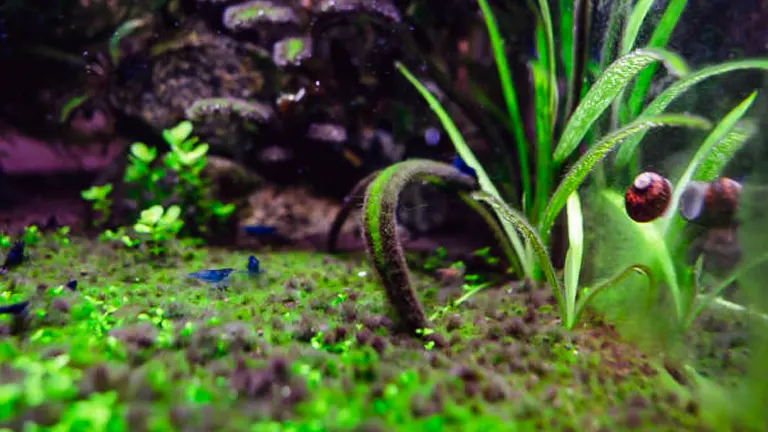
Algae overgrowth is a common issue in many aquariums and can indicate excess nutrients or inadequate lighting conditions. Here’s how to tackle this problem effectively:
Preventing Algae Growth
Managing algae involves regulating light and nutrients to disrupt the algae’s ability to thrive:
- Light Management: Reduce lighting hours to 6-8 hours per day. Use timers to maintain a consistent light schedule.
- Nutrient Control: Perform regular water changes to remove excess nutrients. Test water frequently to monitor nutrient levels and adjust your fertilization strategy accordingly.
- Increase Plant Density: More plants mean more competition for nutrients, leaving less available for algae.
- Use of Algae Eaters: Introduce algae-eating fish or snails to naturally keep algae populations in check.
Handling Plant Diseases
Plant health can be compromised by diseases, which typically manifest as discolored leaves, holes, or stunted growth.
- Early Identification: Regularly inspect plants for signs of disease. Early detection means easier management and less impact on overall plant health.
- Remove Affected Parts: Trim diseased or dead sections promptly to prevent the spread of the disease.
- Adjust Fertilization Practices: Over-fertilization can contribute to diseases. Ensure that nutrient levels are appropriate for the plants’ needs.
Improving Water Clarity
Turbid water not only looks unappealing but can also stress aquatic life.
- Enhanced Filtration: Use high-quality filters to keep the water clean. Regular maintenance of filter systems also helps prevent debris and particle buildup.
- Regular Maintenance: Vacuum the substrate and perform water changes weekly to remove decaying organic matter that contributes to murkiness.
- Use of Water Clarifiers: If mechanical filtration isn’t enough, water clarifiers can bind fine particles, making them easier for the filter to remove.
Related Post
- How to Fertilize a Mango Tree Effectively: Tips and Tricks for Healthy Growth
- How to Fertilize Apple Trees: Essential Tips for a Bountiful Harvest
- How to Fertilize Lemon Trees: Secrets for Thriving Citrus
- How to Fertilize Avocado Tree: A Step-by-Step Guide for Lush Growth
Conclusion
Fertilizing aquarium plants naturally not only promotes a lush, healthy aquatic environment but also aligns with sustainable practices that benefit both your home ecosystem and the planet. This guide has outlined methods from basic setups to more advanced techniques, emphasizing the importance of understanding plant needs and ecosystem balance. By adopting natural fertilization methods, aquarium hobbyists can enjoy vibrant plant growth and clear water, contributing to the overall health and beauty of their aquatic gardens.
FAQs
- What are the best natural fertilizers for aquarium plants?
The best natural fertilizers for aquarium plants include compost tea, liquid organic fertilizers made from worm castings, and homemade preparations from kitchen waste such as banana peels, eggshells, and coffee grounds. These options provide a balanced supply of nutrients, are cost-effective, and reduce the risk of chemical buildup that can harm aquatic life. - How often should I fertilize my aquarium plants naturally?
The frequency of fertilization depends on the type of plants, the growth phase, and the existing nutrient levels in the aquarium. Typically, a moderate application every two weeks is sufficient. However, during periods of active growth or for heavily planted tanks, weekly fertilization might be necessary to maintain optimal growth and health. - Can I use tap water to make compost tea for my aquarium plants?
Yes, tap water can be used to make compost tea, but it should be dechlorinated before use because chlorine in tap water can kill the beneficial bacteria that break down organic matter in compost. Letting tap water sit uncovered for 24-48 hours or using a dechlorinator can remove chlorine effectively. - What signs indicate that my aquarium plants are nutrient-deficient?
Common signs of nutrient deficiency include pale or yellowing leaves (nitrogen deficiency), slow or stunted growth (phosphorus deficiency), and pinholes or yellow patches on leaves (potassium deficiency). Iron deficiency might show as pale leaves with dark veins. Regular monitoring helps in early detection and correction of these issues. - How can I adjust the pH of my aquarium naturally for optimal plant growth?
Adjusting the pH naturally can be achieved by adding peat moss to the filter or directly to the substrate, using driftwood, or incorporating catappa leaves, all of which release tannic acids that naturally lower pH. However, any adjustments should be made gradually to avoid stressing the fish. - Is it possible to over-fertilize aquarium plants with natural fertilizers?
Yes, even natural fertilizers can lead to over-fertilization, which may cause nutrient imbalances, promote excessive algae growth, or harm plant and fish health. Symptoms of over-fertilization include algae overgrowth, cloudy water, and inhibited plant growth. Regular testing of water parameters is crucial to avoid these issues. - What are some effective natural methods to deal with algae while fertilizing?
To naturally control algae while fertilizing aquarium plants, ensure balanced nutrient levels and adequate plant density to compete with algae for nutrients. Utilizing algae-eating species such as certain fish, shrimp, or snails can also help manage algae levels. Additionally, regulating light exposure to 8-10 hours a day can significantly reduce algae growth. - How do I know if the natural fertilization method is effective for my aquarium plants?
The effectiveness of natural fertilization is indicated by healthy, vibrant plant growth, with deep green leaves and strong roots. An increase in plant mass and the absence of deficiency symptoms also suggest successful nutrient uptake. Regular testing of water for nutrient levels and observing plant health are reliable methods to assess the effectiveness of your fertilization regimen.
Utilizing natural fertilization methods promises a vibrant, healthy aquatic garden, paving the way for sustainable growth. With these practices, your underwater world will not only flourish but also resonate with the harmony of nature itself.

Emma Hudson
Forestry AuthorEmma's experience in farming shapes her detailed guides on gardening and farming tools, providing practical, actionable advice grounded in real-world experience. Her work targets both newcomers and experienced farmers, aiming to enhance their practices with a mix of traditional wisdom and modern techniques. By making complex agricultural concepts accessible, Emma's guides serve as valuable tools for those navigating the challenges of contemporary farming, offering strategies for sustainable success.













So what's the secret recipe for this fertilizer "tea" ? It would be nice to know what the ratios are supposed to be and how much to use per gallon etc .
mike
August 14, 2024 12:22 am